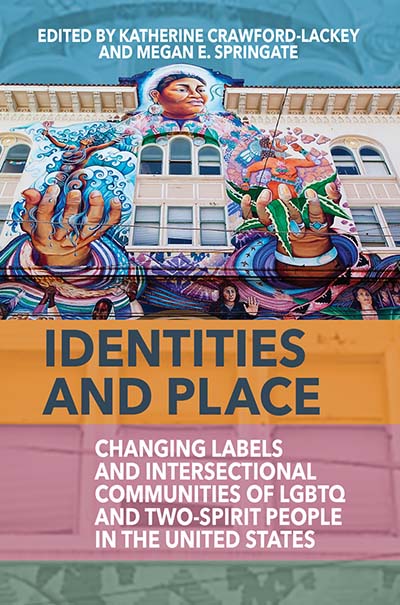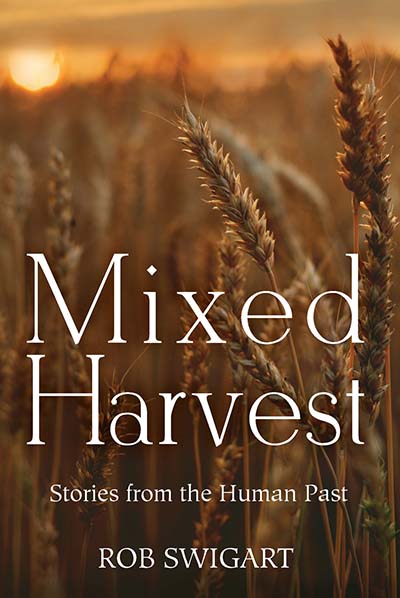
We are delighted to inform you that Berghahn Books will be attending the Society for Historical Archaeology‘s annual meeting on January 8–11, 2020. Please stop by Table #23 to browse our selection of books at discounted prices and meet Archaeology, Heritage Studies and Museum Studies Editor Caryn M. Berg!
If you are unable to attend the conference, we are currently offering a 25% discount on Berghahn archaeology titles in all formats until February 11th 2020! Please use discount code SHA20. Browse the following new and recent titles in Archaeology below.
Check out our 2020 Archaeology catalog for a full list of new and recent titles.
Featured Titles
BORN A SLAVE, DIED A PIONEER
Nathan Harrison and the Historical Archaeology of Legend
Seth Mallios
Few people in the history of the United States embody ideals of the American Dream more than Nathan Harrison. His is a story with prominent themes of overcoming staggering obstacles, forging something-from-nothing, and evincing gritty perseverance. In a lifetime of hard-won progress, Harrison survived the horrors of slavery in the Antebellum South, endured the mania of the California Gold Rush, and prospered in the rugged chaos of the Wild West. This book uses spectacular recent discoveries from the Nathan Harrison cabin site to offer new insights and perspectives into this most American biography.
Read Introduction
AN ARCHAEOLOGY OF UNCHECKED CAPITALISM
The American Rust Belt to the Developing World
Paul A. Shackel
The racialization of immigrant labor and the labor strife in the coal and textile communities in northeastern Pennsylvania appears to be an isolated incident in history. Rather this history can serve as a touchstone, connecting the history of the exploited laborers to today’s labor in the global economy. By drawing parallels between the past and present – for example, the coal mines of the nineteenth-century northeastern Pennsylvania and the sweatshops of the twenty-first century in Bangladesh – we can have difficult conversations about the past and advance our commitment to address social justice issues.
Read Introduction
THE SOUND OF SILENCE
Indigenous Perspectives on the Historical Archaeology of Colonialism
Edited by Tiina Äikäs and Anna-Kaisa Salmi
Afterword by Alistair Paterson and Shino Konishi
Colonial encounters between indigenous peoples and European state powers are overarching themes in the historical archaeology of the modern era, and postcolonial historical archaeology has repeatedly emphasized the complex two-way nature of colonial encounters. This volume examines common trajectories in indigenous colonial histories, and explores new ways to understand cultural contact, hybridization and power relations between indigenous peoples and colonial powers from the indigenous point of view. By bringing together a wide geographical range and combining multiple sources such as oral histories, historical records, and contemporary discourses with archaeological data, the volume finds new multivocal interpretations of colonial histories.
Read Introduction
PRESERVATION AND PLACE
Historic Preservation by and of LGBTQ Communities in the United States
Edited by Katherine Crawford-Lackey and Megan E. Springate
Significant historic and archaeological sites affiliated with two-spirit, lesbian, gay, bisexual, transgender, and queer history in the United States are examined in this unique volume. The importance of the preservation process in documenting and interpreting the lives and experiences of queer Americans is emphasized. The book features chapters on archaeology and interpretation, as well as several case studies focusing on queer preservation projects. The accessible text and associated activities create an interactive and collaborative process that encourages readers to apply the material in a hands-on setting.
Read Preface
IDENTITIES AND PLACE
Changing Labels and Intersectional Communities of LGBTQ and Two-Spirit People in the United States
Edited by Katherine Crawford-Lackey and Megan E. Springate
With a focus on historic sites, this volume explores the recent history of non-heteronormative Americans from the early twentieth century onward and the places associated with these communities. Authors explore how queer identities are connected with specific places: places where people gather, socialize, protest, mourn, and celebrate. The focus is deeper look at how sexually variant and gender non-conforming Americans constructed identity, created communities, and fought to have rights recognized by the government. Each chapter is accompanied by prompts and activities that invite readers to think critically and immerse themselves in the subject matter while working collaboratively with others.
Read Preface
INVISIBLE FOUNDERS
How Two Centuries of African American Families Transformed a Plantation into a College
Lynn Rainville
Literal and metaphorical excavations at Sweet Briar College reveal how African American labor enabled the transformation of Sweet Briar Plantation into a private women’s college in 1906. This volume tells the story of the invisible founders of a college founded by and for white women. Despite being built and maintained by African American families, the college did not integrate its student body for sixty years after it opened. In the process, Invisible Founders challenges our ideas of what a college “founder” is, restoring African American narratives to their deserved and central place in the story of a single institution — one that serves as a microcosm of the American South.
Read Preface
MAGICAL HOUSE PROTECTION
The Archaeology of Counter-Witchcraft
Brian Hoggard
Belief in magic and particularly the power of witchcraft was once a deep and enduring presence in popular culture; people created and concealed many objects to protect themselves from harmful magic. Detailed are the principal forms of magical house protection in Britain and beyond from the fourteenth century to the present day. Witch-bottles, dried cats, horse skulls, written charms, protection marks and concealed shoes were all used widely as methods of repelling, diverting or trapping negative energies. Many of these practices and symbols can be found around the globe, demonstrating the universal nature of efforts by people to protect themselves from witchcraft.
Read Preface
Historical Fiction
MIXED HARVEST
Scenes from the Human Past
Robert Swigart
In unforgettable stories of the human journey, a combination of storytelling and dialogue underscore an excavation into the deep past of human development and its consequences. Through a first encounter between a Neanderthal woman and the Modern Human she called Traveler, to the emergence and destruction of the world’s first cities, Mixed Harvest tells the tale of the Sedentary Divide, the most significant event since modern humans emerged. Rob Swigart’s latest work humanizes the rapid transition to agriculture and pastoralism with a grounding in the archaeological record.
Read Preface
For Your Archaeology Courses
EXPERIENCING ARCHAEOLOGY
A Laboratory Manual of Classroom Activities, Demonstrations, and Minilabs for Introductory Archaeology
Lara Homsey-Messer, Tracy Michaud, Angela Lockard Reed, and Victoria Bobo
See accompanying Instructor’s Edition
Today, many general-education archaeology courses are large, lecture-style class formats that present a challenge to providing students, particularly non-majors, with opportunities to learn experientially. This laboratory-style manual compiles a wide variety of uniquely designed, hands-on classroom activities to acquaint advanced high school and introductory college students to the field of archaeology. Ranging in length from five to thirty minutes, activities created by archaeologists are designed to break up traditional classroom lectures, engage students of all learning styles, and easily integrate into large classes and/or short class periods that do not easily accommodate traditional laboratory work.
Read Introduction
Forthcoming February 2020!
CULTURAL RESOURCE MANAGEMENT
A Collaborative Primer for Archaeologists
Thomas F. King
Stressing the interdisciplinary, public-policy oriented character of Cultural Resource Management (CRM), which is not merely “applied archaeology,” this short, relatively uncomplicated introduction is aimed at emerging archaeologists. Drawing on fifty-plus years’ experience, and augmented by the advice of fourteen collaborators, Cultural Resource Management explains what “CRM archaeologists” do, and explores the public policy, ethical, and pragmatic implications of doing it for a living.
PLAYING WITH THE PAST
Exploring Values in Heritage Practice
Kate Clark
Heritage is all around us, not just in monuments and museums, but in places that matter, in the countryside and in collections and stories. It touches all of us. How do we decide what to preserve? How do we make the case for heritage when there are so many other priorities? Playing with the Past is the first ever action-learning book about heritage. Over eighty creative activities and games encompass the basics of heritage practice, from management and decisionmaking to community engagement and leadership. Although designed to ‘train the trainers’, the activities in the book are relevant to anyone involved in caring for heritage.
Read Preface
ARCHAEOGAMING
An Introduction to Archaeology in and of Video Games
Andrew Reinhard
“Reinhard’s willingness to move between the densely philosophical, the methodological, and the colloquial would make this book a nice option for an introductory archaeology class where students learn about theory, methods, procedures, and techniques, but less frequently have opportunities to put these ideas into practice…Reinhard’s book provides both the student and the scholar a way to think about what this kind of work will look like.” • The Archaeology of the Mediterranean World
Read Introduction
PUBLIC ENGAGEMENT AND EDUCATION
Development and Fostering Stewardship for an Archaeological Future
Edited by Katherine M. Erdman
The world’s collective archaeological heritage is threatened by war, development, poverty, climate change, and ignorance. To protect our collective past, archaeologists must involve the general public through interpersonal experiences that develop an interest in the field at a young age and foster that interest throughout a person’s life. Contributors to this volume share effective approaches for engaging and educating learners of all ages about archaeology and how one can encourage them to become stewards of the past. They offer applied examples that are not bound to specific geographies or cultures, but rather, are approaches that can be implemented almost anywhere.
Read Introduction
Archaeology Series Collection
International Monographs in Prehistory:
Archaeological Series and Ethnoarchaeology Series
International Monographs in Prehistory publishes monographs in all areas of archaeological and ethnoarchaeological research. There are no geographical, topical, temporal, or other specific limitations. Monographs should pursue both data and theory, but never data devoid of theoretical context and impact, nor theory which is not exemplified by or tested against data. Although a distinction is often drawn between theoretical and substantive works in archaeology, this series seeks work of significance containing elements of both theory and substance. Monographs in the series will have immediate impact and long-lasting value in the field.
New!
Digital Archaeology: Documenting the Anthropocene
Andrew Reinhard, Series Editor
The new archaeology of the late 20th and 21st centuries (the Anthropocene) supplements traditional landscapes, sites, and artifacts with those that are digital. People increasingly inhabit digital places, investing time and money into spaces accessed only by screens. Corporations continue to create these mass-produced digital built environments in the form of hardware and software on both physical and cloud-based media. This series aims to answer the questions of what digital heritage looks like and how it can be understood archaeologically.
New!
Studies in Post-Industrial Life
Michael Roller and Paul A. Shackel, Series Editors
The industrial world has experienced a profound upheaval over the last few decades as long-established modes of stable regional economic growth have given way to precarity. Post-industrial life is not merely an upheaval in the economic realm, but also reflects profound political, social, cultural, material and aesthetic changes to everyday life. Scholars grapple with understanding the meaning of the remains of post-industrial landscapes and how they are perceived by different stakeholders. This series provides an avenue for scholars to discuss the post-industrial landscape as a political project that has an outcome in urban and environmental decay.
Follow us on Social Media
For updates on these and other Berghahn titles as well as all other exciting developments from Berghahn, sign up for customized e-Newsletters, become a Facebook fan, or follow us on Twitter.














